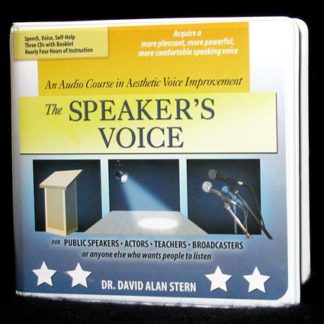Description
Reducing an African-American Accent
WHAT WILL YOU DOWNLOAD?
The download contains eighty (80) minutes of systematic instruction in MP3 sound files. You’ll also get a printable PDF of the instruction manual. It contains summaries of the audio lessons and full transcripts of the drill words, phrases, and passages.
WHAT WILL YOU LEARN?
You’ll learn the resonance (voice placement), inflections, and pronunciation of the “General American” or “American Non-Regional” accent. You’ll use a program Dr. Stern developed specifically for people who speak with African-American accents. Here’s the program’s sequence of instruction.
- Lesson 1 teaches the mouth-movement style that generates the mid-mouth non-regional resonance. This brings the voice focus slightly farther back in the mouth and changes the style of mid-tongue movement during speech.
- The 2nd Lesson helps you generate non-regional vowel pronunciations directly out of the new mouth movements and posture.
- Lesson 3 teaches the non-regional R sound when it comes after vowels. This is in direct contrast to the African-American accent’s non-rhotic or dropped R’s.
- Lesson 4 addresses a more distinct pronunciation of the L sound when it follows a vowel.
- The 5th Lesson contrasts the pronunciation of several consonants and consonant clusters with their counterparts in the African-American accent.
- Lesson 6 puts the non-regional accent together in several drill passages. It first reminds you about the resonance. Then, it walks you through target pronunciations phrase by phrase before leading you toward a normal speaking pace.
IS THERE ONE STANDARD NON-REGIONAL ACCENT?
Folks often ask me exactly where in the USA people speak American English “without an accent.” WELL! Pretty much all Americans grow up speaking a local accent. It’s just that we call some of those variations “no accent” or “non-regional accents.” So, for better or worse, here’s what I mean by that term.
I define “Non-Regional American Accent” as oral English that identifies its speakers as native-born Americans. But, at the same time, it does not give most listeners clues that speakers are from specific cities or regions. I don’t believe, however, that there is one absolute standard for “a correct non-regional accent.” Some vowel pronunciations can vary a bit without creating the impression of an accent change.
I unofficially identify two (WELL—maybe three) “brands” of non-regional speech that differ slightly in vowel pronunciations. For example, in my “Eastern Non-Regional” version, there is a rounded vowel in THOUGHT and an unrounded vowel in LOT. In my “Western Non-Regional” version, both words have slightly rounded vowels. In some “non-regional” areas, LOT rounds and THOUGHT does not. But these specific vowel shifts alone usually don’t signal regional changes to most listeners. However, some other vowel differences, especially accompanied by intonation, rhythm, or resonance changes, can read as regional-accent signs to many.




